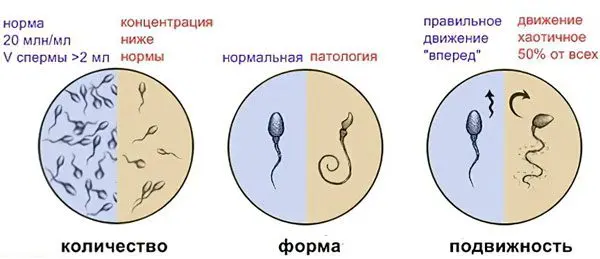Contents

According to various data, from 35 to 45% of cases of inability of families to acquire offspring are associated with male infertility. And the sooner and more accurately the cause of the problem is determined, the sooner the spouses will be able to start treatment and eventually become happy parents. Therefore, if a couple, after a year of regular intimate life without protection, is still not congratulated on the upcoming replenishment, it is necessary to discard embarrassment and fear and go for an examination: the wife – to the gynecologist-reproductologist, the husband – to the urologist-andrologist.
A spermogram is the first and obligatory step towards answering the question of whether a man can have children. This simple laboratory analysis includes indicators such as the total volume of the ejaculate, the number of sperm in it, their viability and motility. In addition, the doctor examines the physicochemical parameters of the sperm and determines the presence of pathological cells in it, which may indicate a disease.

Today we will tell you how to take a spermogram and properly prepare for a visit to the clinic, what are the normal indicators, what do the special terms mean in deciphering the results of the analysis, and most importantly, what to do if the results of the examination are disappointing? How to increase concentration and motility of spermatozoa?
Indication for the study

It is necessary to pass the ejaculate for spermogram in the following cases:
A man is simply interested in his reproductive health and wants to make sure that he is able to become a father;
The partner has not become pregnant for at least one year of regular sexual activity without the use of contraceptives;
A man has been diagnosed with a disease or congenital pathology that can lead to infertility (hypogonadism, varicocele, orchitis, urethritis, prostatitis, etc.);
The couple is going to resort to in vitro fertilization or artificial insemination.
Types of spermograms
There are four main types of this analysis:
Basic spermogram, the norms of which are enshrined by the World Health Organization in 1999;
MAR-test, demonstrating the presence or absence of antisperm antibodies in the ejaculate – these are cells that destroy spermatozoa. They can appear as a result of an endocrine or autoimmune disease, as well as due to the biochemical incompatibility of partners;
Morphological analysis sperm according to Kruger, which allows you to evaluate the physical parameters of male germ cells – the shape of the head, neck and tail;
Biochemical analysis seminal fluid, which shows the content of enzymes, amino acids, carbohydrates, vitamins and minerals in it.
Preparation and submission of analysis

It is very important to observe all the nuances in order to get a reliable result:
If a man is undergoing treatment or using any drugs constantly, this should be reported to his doctor, since some drugs can distort the diagnostic picture. For example, antibiotics should be stopped no later than two weeks before the spermogram;
Before a visit to the laboratory, you should refrain from intimacy for two to five days, ideally three. This refers to any type of sexual activity, including self-satisfaction, that is, during this entire period, a man should not ejaculate. In addition, you can not drink alcohol, go to the bath or sauna. It is unacceptable to go to the clinic in a sick condition, with a high temperature;
The collection of seminal fluid is carried out exclusively in the process of masturbation, interrupted sexual intercourse or oral sex are not suitable for this, since in this case the ejaculate will contain the partner’s biological fluids. Stimulation should take place without the use of saliva or special lubricants, this can also distort the results of the spermogram;
To collect sperm for analysis, a container is issued – a small plastic container with a lid. Some laboratories provide a choice of a special medical condom, devoid of chemicals that affect the composition of seminal fluid. The man is then invited to go into a room where he can be alone and masturbate. In private clinics, such premises can be properly equipped – comfortable environment, videos, magazines. In state medical institutions, this cannot be expected;
It happens that a man cannot relax in an unusual environment, experiences stress, and therefore it is not possible to pass a spermogram directly on the spot. In this case, a container or a medical condom can be purchased at a pharmacy, the ejaculate can be collected at home and the biomaterial delivered to the laboratory. However, this must be done within one hour, while maintaining the natural temperature of the seminal fluid. The easiest way is to clamp the container in the armpit;
The interpretation of the results of the spermogram will be available in a few days, sometimes even the next day – it all depends on the internal routine of a particular medical institution. If there are deviations from the norm, there is no need to be upset, since the indicators of the ejaculate are very changeable and depend on a number of factors. It is recommended to take a spermogram at least three times with breaks of 10-14 days in order to be sure of the reliability of the examination results.
AMIS
EMIS stands for electron microscopic examination of semen. Each individual sperm cell is viewed at 25x magnification. EMIS is performed when performing a spermogram. This study makes it possible to evaluate the cell from the inside by 45 indicators. The patient will receive the result in 14 days.
Indications for EMIS:
Low fertility with normal morphological structure of spermatozoa.
A woman has a history of miscarriages or missed pregnancies.
Unsuccessful IVF attempts (if no other violations are identified).
EMIS can be taken by those couples who are worried about the risks of genetic abnormalities in the child. The analysis allows you to identify violations of chromatin, which forms the basis for chromosomes.
DNA fragmentation
If the sexual partner cannot bear the fetus, it is necessary to carry out DNA fragmentation. The fact is that a frequent cause of miscarriages and miscarriages are sperm abnormalities, in which DNA is torn in the head. The cause of the pathology is the influence of free radicals on germ cells (normally, their protection is provided by antioxidants).
To assess the amount of radicals present in semen, a separate ROS test is performed. To understand the resistance of spermatozoa to radicals, an analysis of the antioxidant capacity of seminal plasma is performed.
DNA fragmentation can be implemented in 2 ways:
HALO test. Spermatozoa are illuminated with special chemicals. A halo appears around healthy cells. Damaged spermatozoa do not glow, normally they should be no more than 20%. If the number of cells varies between 30-50%, then the couple needs to think about IVF, when this number rises to 50% – about ICSI, and more than 60% – about finding a sperm donor. Results will be available in 1-3 days.
Tunnel. During the study, only those spermatozoa that have abnormalities in DNA will be highlighted. This is an expensive and time-consuming study. Its accuracy is lower than that of the HALO test. The results of the analysis will be ready in 14-21 days.









